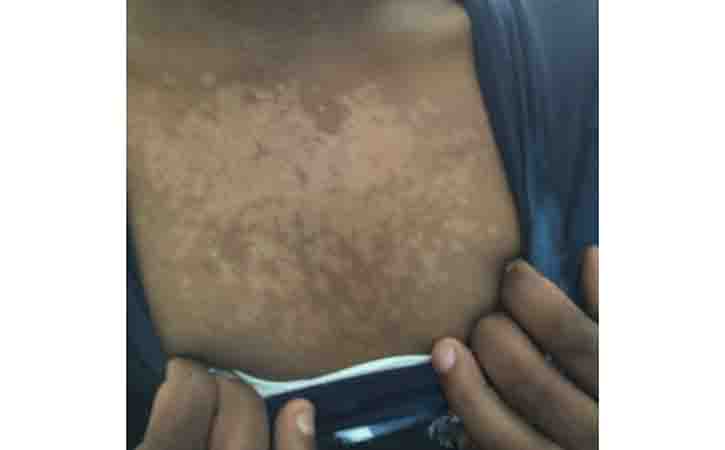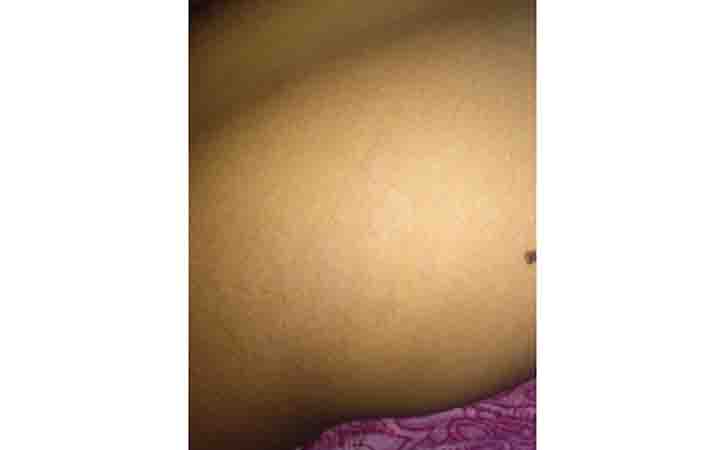Pityriasis Versicolor
Pityriasis versicolor (PV), also known as tinea versicolor, is a common, benign, superficial cutaneous fungal infection usually characterized by hypopigmented or hyperpigmented macules and patches on the chest and the back. In patients with a predisposition, tinea versicolor may chronically recur. The fungal infection is localized to the stratum corneum(outer layer of the epidermis) resulting from a change to the mycelial (filamentous fungus or mould) state of dimorphic yeasts of the genus Malassezia. The lesions are: (a) flat; (b) only partially depigmented—areas of vitiligo are totally white; and (c) do not show inflammation or vesicles.
Although the alteration in skin pigmentation is more apparent in darker-skinned individuals, the incidence of tinea versicolor appears to be the same in all races.
Several studies have addressed the frequency of tinea versicolor based on sex, and no dominance of either sex is apparent.
Tinea versicolor is common in persons aged 15-24 years, when the sebaceous glands are more active. The occurrence of tinea versicolor before puberty or after age 65 years is uncommon. In more tropical countries, age frequency varies, most cases involve people aged 10-19 years who live in warmer, humid countries, Like: Liberia and India.

Acidic bleach from the growing yeast causes areas of skin to be a different color than the skin around them. These can be individual spots or patches. Specific signs and symptoms of the infection include:
- Patches that may be white, pink, red, or brown and can be lighter or darker than the skin around them,
- Skin became dry, itchy, and scaly, more prominent with tanning,
- Spots that do not tan the way the rest of your skin does,
- Spots that may occur anywhere on body but are most commonly seen on the neck, chest, back, and arms.
The spots may disappear during cool weather and get worse during warm and humid weather. They may be dry and scaly and may itch or hurt, although this is not common.
Some conditions with overlapping symptoms, such as vitiligo, are often mistaken for tinea versicolor. However, vitiligo can differ from tinea versicolor in several noticeable ways, including:
- Vitiligo doesn’t affect skin’s texture,
- Vitiligo usually appears on the fingers, wrists, armpits, mouth, eyes, or groin,
- Vitiligo often forms patches that are symmetrical.



The causative organism is a yeast, Pityrosporum orbiculare, that takes advantage of some unknown change in the epidermis and develops a proliferative, stubby, mycelial form, Malassezia furfur.Tinea versicolor occurs when Malassezia grows rapidly on the surface of the skin. Some factors may promote the growth of this yeast on the skin, including:
- hot and humid weather
- excessive sweating
- oily skin
- a weakened immune system
- hormonal changes
Because the yeast grows naturally on skin, tinea versicolor is not contagious. The condition can affect people of any skin color. It’s more likely to affect teens and young adults.
Tinea versicolor responds well to both topical and oral antimycotic therapies. Many patients prefer oral therapy because of its convenience. If symptoms aren’t severe, may choose to treat condition at home. Oral therapy for tinea versicolor is convenient and effective, but it does not prevent recurrences. Antifungal creams or shampoos may be effective for killing the infection. Examples of medications that can be used to treat tinea versicolor include:
- Clotrimazole: Clotrimazole topical is a broad-spectrum antifungal agent that inhibits yeast growth by altering cell membrane permeability, causing fungal cell death. Reevaluate the analyze if no clinical improvement is seen after 4 weeks.
- miconazole
- selenium sulfide
- terbinafine: Terbinafine topical inhibits squalene epoxidase, which decreases ergosterol synthesis, causing fungal cell death. Use this medication until symptoms significantly improve. The duration of treatment should be greater than 1 week but not greater than 4 weeks.
If seek medical attention for tinea versicolor, doctor may prescribe different medications, like: topical creams that can be applied directly to the skin. Examples include:
- ciclopirox: Ciclopirox interferes with the synthesis of DNA, RNA, and protein by inhibiting the transport of essential elements in fungal cells.
- ketoconazole
Doctor may also prescribe pills to treat tinea versicolor, including:
- fluconazole
- itraconazole
- ketoconazole: Ketoconazole is an imidazole broad-spectrum antifungal agent. It inhibits the synthesis of ergosterol, causing cellular components to leak, resulting in fungal cell death. Ketoconazole achieves excellent skin levels with minimal oral dosing, but oral treatment with this agent for skin infections is contraindicated because of safety concerns.
Long-Term Monitoring: Tinea versicolor has a high rate of recurrence, and prophylactic treatment with topical or oral therapy on an intermittent basis is necessary to prevent recurrences in most cases.
To confirm analyze, need to visit a doctor. In long term treatment, must consult with a doctor.
Also if concern about skin, visit a doctor before using medication, not only oral medication but also tropical.
- ABC Of Dermatology
- Clinical Dermatology
- Roxburgh’s common skin diseases,
- Andrew’s Diseases of the skin.
Pityriasis Versicolor
TUI - Tibot Urgency Index


Pityriasis versicolor (PV), also known as tinea versicolor, is a common, benign, superficial cutaneous fungal infection usually characterized by hypopigmented or hyperpigmented macules and patches on the chest and the back. In patients with a predisposition, tinea versicolor may chronically recur. The fungal infection is localized to the stratum corneum(outer layer of the epidermis) resulting from a change to the mycelial (filamentous fungus or mould) state of dimorphic yeasts of the genus Malassezia. The lesions are: (a) flat; (b) only partially depigmented—areas of vitiligo are totally white; and (c) do not show inflammation or vesicles.
Although the alteration in skin pigmentation is more apparent in darker-skinned individuals, the incidence of tinea versicolor appears to be the same in all races.
Several studies have addressed the frequency of tinea versicolor based on sex, and no dominance of either sex is apparent.
Tinea versicolor is common in persons aged 15-24 years, when the sebaceous glands are more active. The occurrence of tinea versicolor before puberty or after age 65 years is uncommon. In more tropical countries, age frequency varies, most cases involve people aged 10-19 years who live in warmer, humid countries, Like: Liberia and India.



Acidic bleach from the growing yeast causes areas of skin to be a different color than the skin around them. These can be individual spots or patches. Specific signs and symptoms of the infection include:
- Patches that may be white, pink, red, or brown and can be lighter or darker than the skin around them,
- Skin became dry, itchy, and scaly, more prominent with tanning,
- Spots that do not tan the way the rest of your skin does,
- Spots that may occur anywhere on body but are most commonly seen on the neck, chest, back, and arms.
The spots may disappear during cool weather and get worse during warm and humid weather. They may be dry and scaly and may itch or hurt, although this is not common.
Some conditions with overlapping symptoms, such as vitiligo, are often mistaken for tinea versicolor. However, vitiligo can differ from tinea versicolor in several noticeable ways, including:
- Vitiligo doesn’t affect skin’s texture,
- Vitiligo usually appears on the fingers, wrists, armpits, mouth, eyes, or groin,
- Vitiligo often forms patches that are symmetrical.



The causative organism is a yeast, Pityrosporum orbiculare, that takes advantage of some unknown change in the epidermis and develops a proliferative, stubby, mycelial form, Malassezia furfur.Tinea versicolor occurs when Malassezia grows rapidly on the surface of the skin. Some factors may promote the growth of this yeast on the skin, including:
- hot and humid weather
- excessive sweating
- oily skin
- a weakened immune system
- hormonal changes
Because the yeast grows naturally on skin, tinea versicolor is not contagious. The condition can affect people of any skin color. It’s more likely to affect teens and young adults.
Tinea versicolor responds well to both topical and oral antimycotic therapies. Many patients prefer oral therapy because of its convenience. If symptoms aren’t severe, may choose to treat condition at home. Oral therapy for tinea versicolor is convenient and effective, but it does not prevent recurrences. Antifungal creams or shampoos may be effective for killing the infection. Examples of medications that can be used to treat tinea versicolor include:
- Clotrimazole: Clotrimazole topical is a broad-spectrum antifungal agent that inhibits yeast growth by altering cell membrane permeability, causing fungal cell death. Reevaluate the analyze if no clinical improvement is seen after 4 weeks.
- miconazole
- selenium sulfide
- terbinafine: Terbinafine topical inhibits squalene epoxidase, which decreases ergosterol synthesis, causing fungal cell death. Use this medication until symptoms significantly improve. The duration of treatment should be greater than 1 week but not greater than 4 weeks.
If seek medical attention for tinea versicolor, doctor may prescribe different medications, like: topical creams that can be applied directly to the skin. Examples include:
- ciclopirox: Ciclopirox interferes with the synthesis of DNA, RNA, and protein by inhibiting the transport of essential elements in fungal cells.
- ketoconazole
Doctor may also prescribe pills to treat tinea versicolor, including:
- fluconazole
- itraconazole
- ketoconazole: Ketoconazole is an imidazole broad-spectrum antifungal agent. It inhibits the synthesis of ergosterol, causing cellular components to leak, resulting in fungal cell death. Ketoconazole achieves excellent skin levels with minimal oral dosing, but oral treatment with this agent for skin infections is contraindicated because of safety concerns.
Long-Term Monitoring: Tinea versicolor has a high rate of recurrence, and prophylactic treatment with topical or oral therapy on an intermittent basis is necessary to prevent recurrences in most cases.
To confirm analyze, need to visit a doctor. In long term treatment, must consult with a doctor.
Also if concern about skin, visit a doctor before using medication, not only oral medication but also tropical.
- ABC Of Dermatology
- Clinical Dermatology
- Roxburgh’s common skin diseases,
- Andrew’s Diseases of the skin.




